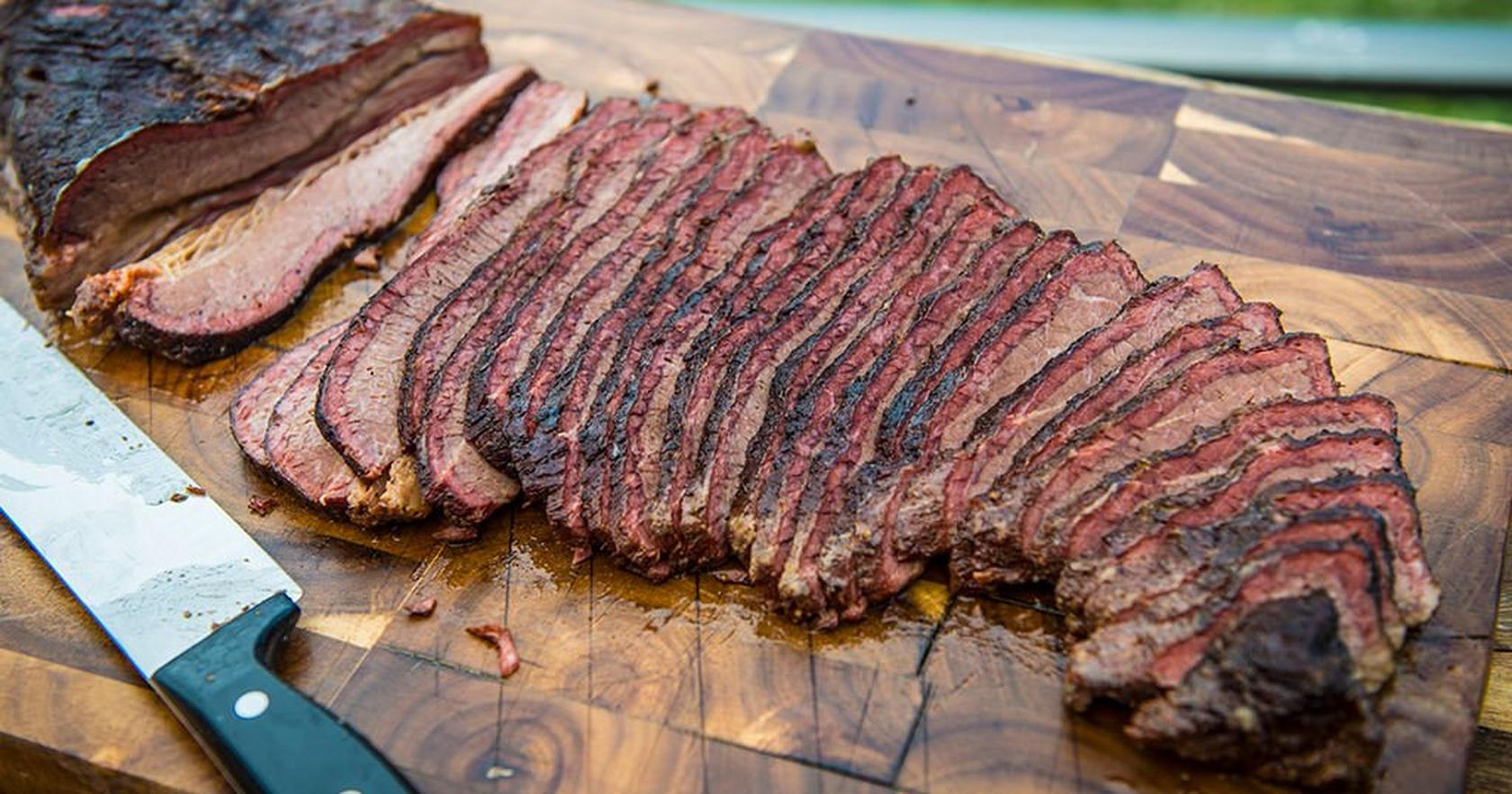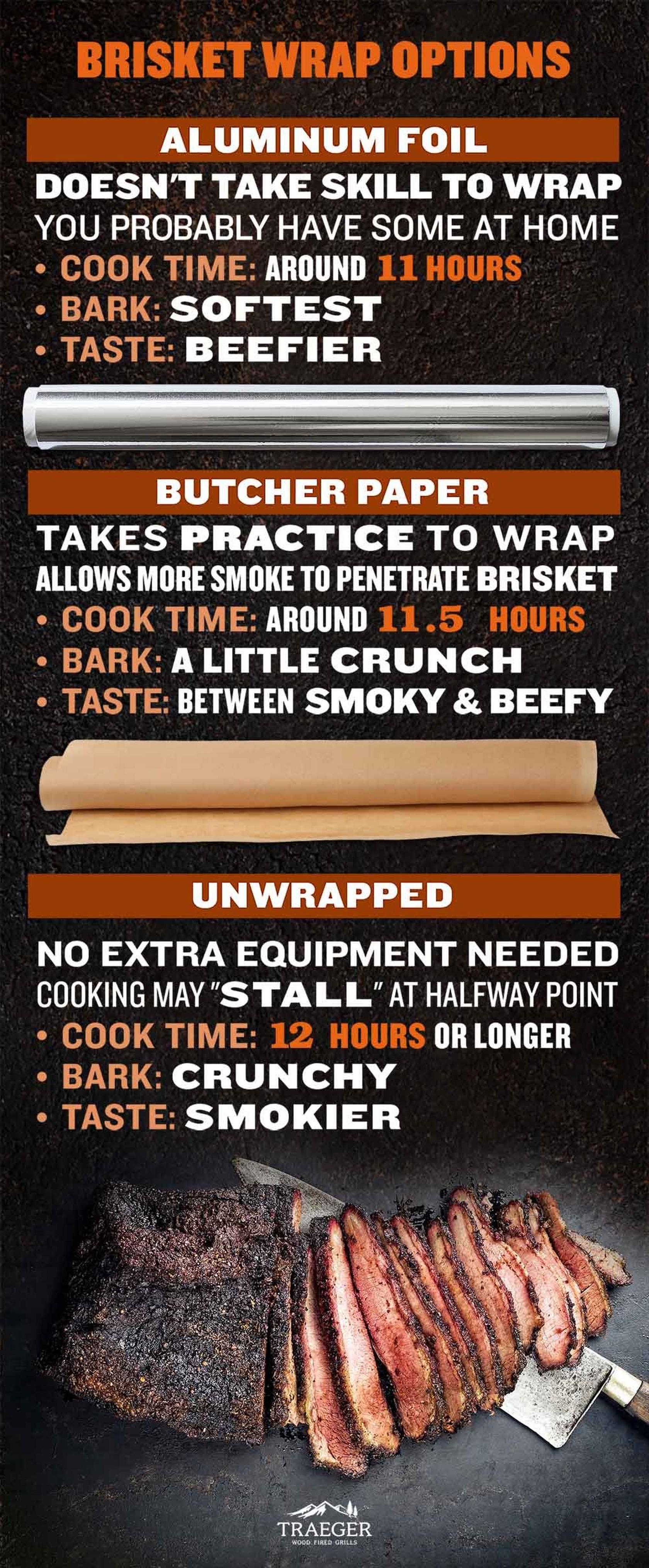When it comes to mastering the perfect smoked brisket, knowing when to wrap brisket and how is a game-changer that takes your BBQ skills from good to legendary on your Traeger Grill.
Wrapping brisket is encasing a not-yet-fully cooked brisket in foil or paper, then continuing the cooking process. The technique was pioneered by competition barbecue experts, and is sometimes called "The Texas Crutch."
How to Wrap a Brisket
Wrapping a brisket in butcher paper or aluminum foil will speed up the cooking process.
Wrapping the brisket will prevent what's called "the stall" — when evaporation from the surface of the brisket halts the cooking process. It also gives you more control over the final appearance of the bark, and can help lock in moisture that would otherwise be lost as the brisket cooks.
Most pitmasters recommend wrapping the brisket when the internal temperature of the meat reaches 165-170°F. You can measure this easily by using the MEATER thermometer.
Below, Chad Ward demonstrates how to wrap a brisket in both butcher paper and foil.
When To Wrap Brisket
When you're trying to decide when to wrap brisket, most barbecue experts recommend wrapping brisket when it reaches an internal temperature of 165-170°F.
Why Do You Want to Wrap a Brisket?
There are three main reasons for wrapping brisket.
- Faster cooking time
- Control over the bark
- Juicier meat
Why Wrapping Brisket Helps It Cook Faster
All large cuts of meat are subject to the stall. Your large cut of meat can be progressing nicely and right on track for when you want to serve it. Then, when the internal temperature of the meat gets near 165°F, it seemingly stops cooking. That's when to wrap brisket—a critical moment that helps push through the stall and ensures your meat finishes cooking to tender perfection.
What's happening? The same process that keeps you cooler on a hot day. Evaporation. Basically, the meat starts to sweat, water rises to the surface of the meat and begins to evaporate, and it cools the entire cut. The battle between evaporation and your smoking becomes a stalemate, and the stall begins. It can last as long as six hours.
When you wrap a brisket, you're eliminating the air into which moisture can evaporate. A film of the brisket's own juices surrounds its surface, and those juices stay hot because of the hot air circulating in your smoker. The less air that circulates around the surface of the meat, the hotter it gets.
Because the wrap insulates the brisket against any direct heat from the smoke, you can increase the temperature of your smoker without worrying about drying out or burning the surface of the meat.
(Note: Traeger expert Matt Pittman keeps his Traeger set at 275°F through the entire brisket cooking process.)
With evaporation stopped, the heat of your smoker pulls ahead in the battle of the stall. The temperature of the meat begins to rise again -- which you want because brisket gets more tender the longer you cook it.
Legend has it "The Texas Crutch" first came into being on the competition barbecue circuit. In these contests, smoked meat must be delivered to the judges at a specific time. Wrapping brisket -- the traditional cut of Texans -- helped competitors hit their deadlines.
Control Over the Bark
When you wrap, you have more control over the appearance of the brisket. What most pitmasters are going for is a mahogany-colored crust on the surface of the meat called the bark.
A good bark looks delicious and appetizing, but that's not all. Bark also contains the pleasing effects of the Maillard reaction, a chemical process that releases the aromas and flavors our minds register as "cooked” meat.
So while some wrap their brisket when it gets to the stall temperature, knowing when to wrap brisket is also about achieving the perfect bark color and thickness you desire.
However, while the brisket is wrapped, the juices of the meat can moisten the bark, making it less crispy. We'll explain how to avoid that later in the article.
Juicier Meat
Wrapping brisket locks in the delicious and tenderizing natural juices of the meat. Once you’ve smoked the brisket, you wrap and start braising it. Some people think you get more smoke flavor but the meat soaks up all the smoke up until the stall time.
Wrapping meat is a traditional technique for locking in flavor and juiciness, especially in tropical environments where leaves are used. This is the same concept.
Are There Downsides to Wrapping Brisket?
The main disadvantage of when to wrap brisket is that a wrapped brisket will taste slightly less smoky than it would if you left it unwrapped. Other downsides include possible loss of texture to the bark, and the risk of overcooking.
Slight Loss of Smoke Flavor
When you wrap the brisket, you create a barrier between the wood smoke and the meat. For this reason, less smoke flavor is being imparted to the meat.
But it's not that big of a deal, because you will already have the meat exposed to the smoke for several hours before you wrap it. Most of the smoke flavor gets into the meat in those first few hours of cooking. The benefits of wrapping -- faster cooking time, control of the bark, and juicier meat -- outweigh the slight loss of smoke flavor. To get the most flavor from your smoke, consider our robust Mesquite wood pellets for the ultimate wood-fired flavor.
Loss of Texture to Bark
Wrapping a brisket tightly will surround it with a layer of moisture. This helps speed up the cooking process, but will also cause the firm bark on the exterior of the brisket to become softer
After you have the meat at the desired temperature (most experts recommend around 203°F), you can remove the wrap and cook the brisket at about 225°F to re-crisp the bark. Note: The brisket will cool rapidly once you unwrap it, but that's okay. As long as you've gotten it to that 203°F mark, the meat will be tender even though the internal temperature has dropped.
Risk of Overcooking
When you wrap brisket, the internal temperature will begin to rise. There's no telling exactly how rapid the rise will be. It can vary depending on the humidity of the smoker, how tightly you wrap, the quality of the wrapping, the properties of your particular cut of brisket, and other factors.
Beginners sometimes make the mistake of following the timing of a recipe rather than relying on their eyes, nose, or thermometer. The result is overcooked, mushy brisket (and frustration). Trust yourself and cook to temperature, not time. Using a reliable MEATER wireless thermometer, check the temperature of the meat at least every 30 minutes. You can poke right through the wrapping for this, the slight hole you make won't affect the cooking time. Once the thermometer registers 190°F, test every 15 minutes, until the meat hits the desired 203 degrees.
Options for Wrapping Brisket
BBQ experts wrap their brisket in either aluminum foil or butcher paper.
Wrap Brisket in Foil
Aluminum foil is the original Texas Crutch method for wrapping brisket.
To wrap a brisket in foil, measure out two arm-length pieces of heavy-duty aluminum foil. Lay the pieces on top of each other, and the brisket on top of them. Then simply wrap the brisket up as tight as you can.
We recommend foil for beginners. Why? For one thing, it's the easiest method. Aluminum foil is designed to tightly wrap food, and you should be able to do it easily the first time without any practice. Also, you probably have some at home, or can easily buy it at the store.
Because foil creates a very tight seal, it will speed up the cooking process. Again, make sure you are measuring the temperature of your brisket at least every 30 minutes.
One drawback of this tight seal is that the bark you create will get a little moist and soft during this final stage of cooking.
Wrap Brisket in Butcher Paper
Wrapping brisket in butcher paper is the favored method of the top Texas barbecue joints. It speeds up the cooking time like foil does but still allows some smoke to get through which foil doesn't.
Professional cooks smoke dozens of briskets at a time, so they get a lot of practice. And wrapping with butcher paper really does take practice to get right. Watch Traeger pro Matt Pittman's butcher paper brisket wrapping method then decide if it's the best choice for you.
Where to get butcher paper? Our specially-made Traeger pink butcher paper is a terrific option. Or, if you have a specialty butcher shop nearby, they should be able to supply you with some.
Butcher paper soaks up the grease of the brisket, forming a layer of moisture that helps conduct heat and keeps the meat cooking. The paper lets a little bit more smoke through, too, so you'll get more flavor than you would by wrapping with foil. Your bark will stay drier as well.
Those benefits come with a drawback. While cooking with butcher paper should help you avoid the stall, using foil is more of a guarantee. And because the butcher paper isn't as tight a wrap as foil, the cooking time will be a little longer.
@kendrick.bbq Brisket Wrap Hack #kendrickbbq #brisket #wagyu #lifehack #bbq #ramsayreacts @traegergrillsofficial @gordonramsayofficial @meatermade ♬ original sound - @kendrick_bbq
Wrapped or Unwrapped? It's Your Brisket, You Decide
If you don't have a set deadline for finishing your brisket, and you like an extremely smoky, crunchy bark, you might prefer cooking your brisket unwrapped. The unwrapped brisket will take on more smoke, creating a thicker, drier bark on the exterior of the meat.
When left unwrapped, brisket is subject to the dreaded stall when natural evaporation causes a cooling sweat to break out on the meat. This stall can last anywhere from a few minutes to a few hours.
If you feel like your bark is getting too crispy, you can always wrap it at that point, and finish smoking. With a wrapped brisket, you can rest easy knowing that you'll have a faster cooking time, and a tender, juicy beef in every bite.
If you're still deciding, read our expert article on how to smoke a brisket to perfection.

